EAPA3004 - England and Japan Higher Education System Analysis
VerifiedAdded on 2023/06/12
|5
|1213
|66
Essay
AI Summary
This essay provides a comparative analysis of the higher education systems in England and Japan, with a focus on funding policies and quality assurance mechanisms. The English system is characterized by autonomous institutions, increased tuition fees, and a shift towards individualistic benefits, while the Japanese system relies heavily on the Ministry of Education's oversight and emphasizes financial support for research and students. The essay highlights the challenges faced by Japanese universities in globalizing their education and the robust quality assurance strategies employed in England. Despite disparities, both systems offer diverse opportunities for students and academics, contributing to the global flow of knowledge. The conclusion emphasizes the UK universities' ability to deliver focused education cultivating critical engagement within specific disciplines.
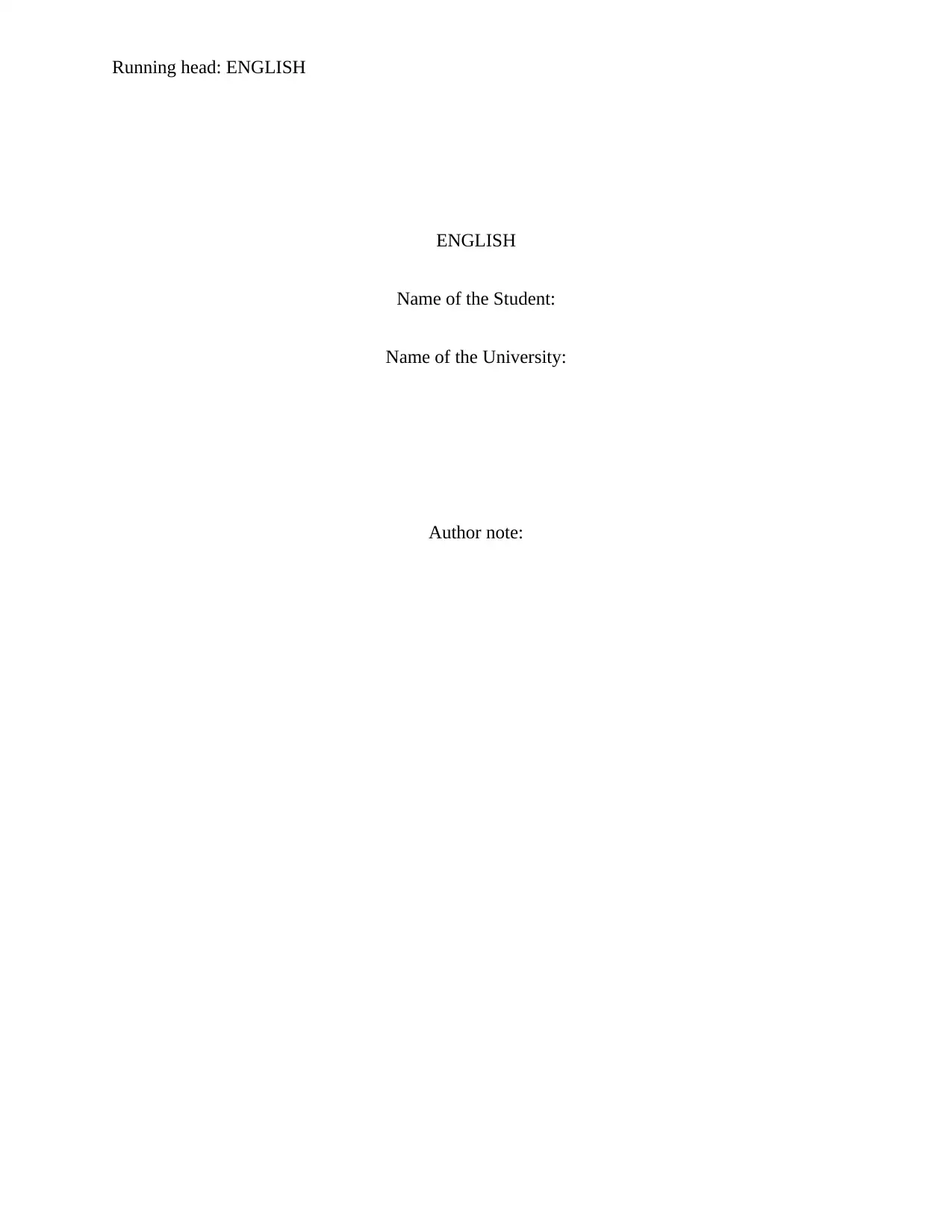
Running head: ENGLISH
ENGLISH
Name of the Student:
Name of the University:
Author note:
ENGLISH
Name of the Student:
Name of the University:
Author note:
Paraphrase This Document
Need a fresh take? Get an instant paraphrase of this document with our AI Paraphraser
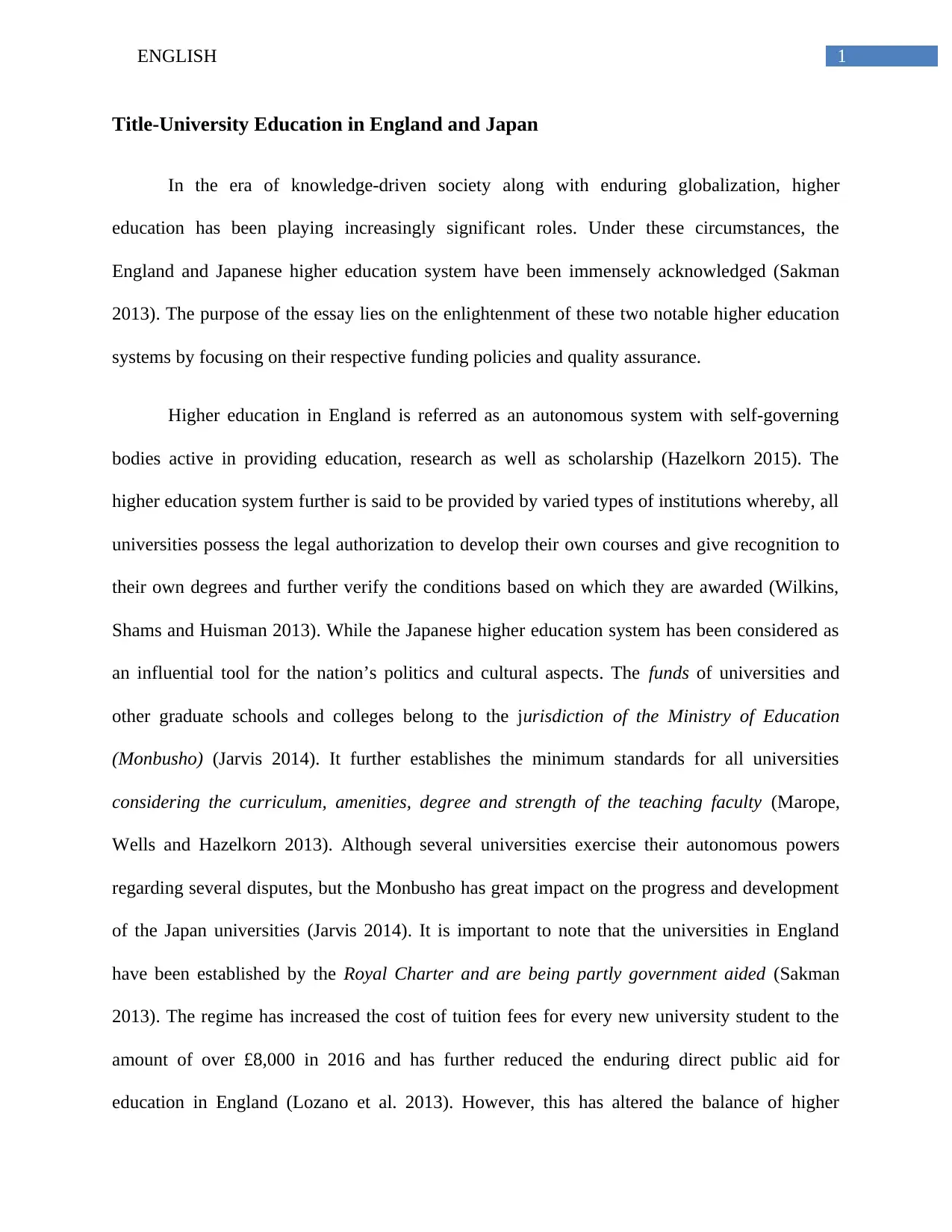
1ENGLISH
Title-University Education in England and Japan
In the era of knowledge-driven society along with enduring globalization, higher
education has been playing increasingly significant roles. Under these circumstances, the
England and Japanese higher education system have been immensely acknowledged (Sakman
2013). The purpose of the essay lies on the enlightenment of these two notable higher education
systems by focusing on their respective funding policies and quality assurance.
Higher education in England is referred as an autonomous system with self-governing
bodies active in providing education, research as well as scholarship (Hazelkorn 2015). The
higher education system further is said to be provided by varied types of institutions whereby, all
universities possess the legal authorization to develop their own courses and give recognition to
their own degrees and further verify the conditions based on which they are awarded (Wilkins,
Shams and Huisman 2013). While the Japanese higher education system has been considered as
an influential tool for the nation’s politics and cultural aspects. The funds of universities and
other graduate schools and colleges belong to the jurisdiction of the Ministry of Education
(Monbusho) (Jarvis 2014). It further establishes the minimum standards for all universities
considering the curriculum, amenities, degree and strength of the teaching faculty (Marope,
Wells and Hazelkorn 2013). Although several universities exercise their autonomous powers
regarding several disputes, but the Monbusho has great impact on the progress and development
of the Japan universities (Jarvis 2014). It is important to note that the universities in England
have been established by the Royal Charter and are being partly government aided (Sakman
2013). The regime has increased the cost of tuition fees for every new university student to the
amount of over £8,000 in 2016 and has further reduced the enduring direct public aid for
education in England (Lozano et al. 2013). However, this has altered the balance of higher
Title-University Education in England and Japan
In the era of knowledge-driven society along with enduring globalization, higher
education has been playing increasingly significant roles. Under these circumstances, the
England and Japanese higher education system have been immensely acknowledged (Sakman
2013). The purpose of the essay lies on the enlightenment of these two notable higher education
systems by focusing on their respective funding policies and quality assurance.
Higher education in England is referred as an autonomous system with self-governing
bodies active in providing education, research as well as scholarship (Hazelkorn 2015). The
higher education system further is said to be provided by varied types of institutions whereby, all
universities possess the legal authorization to develop their own courses and give recognition to
their own degrees and further verify the conditions based on which they are awarded (Wilkins,
Shams and Huisman 2013). While the Japanese higher education system has been considered as
an influential tool for the nation’s politics and cultural aspects. The funds of universities and
other graduate schools and colleges belong to the jurisdiction of the Ministry of Education
(Monbusho) (Jarvis 2014). It further establishes the minimum standards for all universities
considering the curriculum, amenities, degree and strength of the teaching faculty (Marope,
Wells and Hazelkorn 2013). Although several universities exercise their autonomous powers
regarding several disputes, but the Monbusho has great impact on the progress and development
of the Japan universities (Jarvis 2014). It is important to note that the universities in England
have been established by the Royal Charter and are being partly government aided (Sakman
2013). The regime has increased the cost of tuition fees for every new university student to the
amount of over £8,000 in 2016 and has further reduced the enduring direct public aid for
education in England (Lozano et al. 2013). However, this has altered the balance of higher
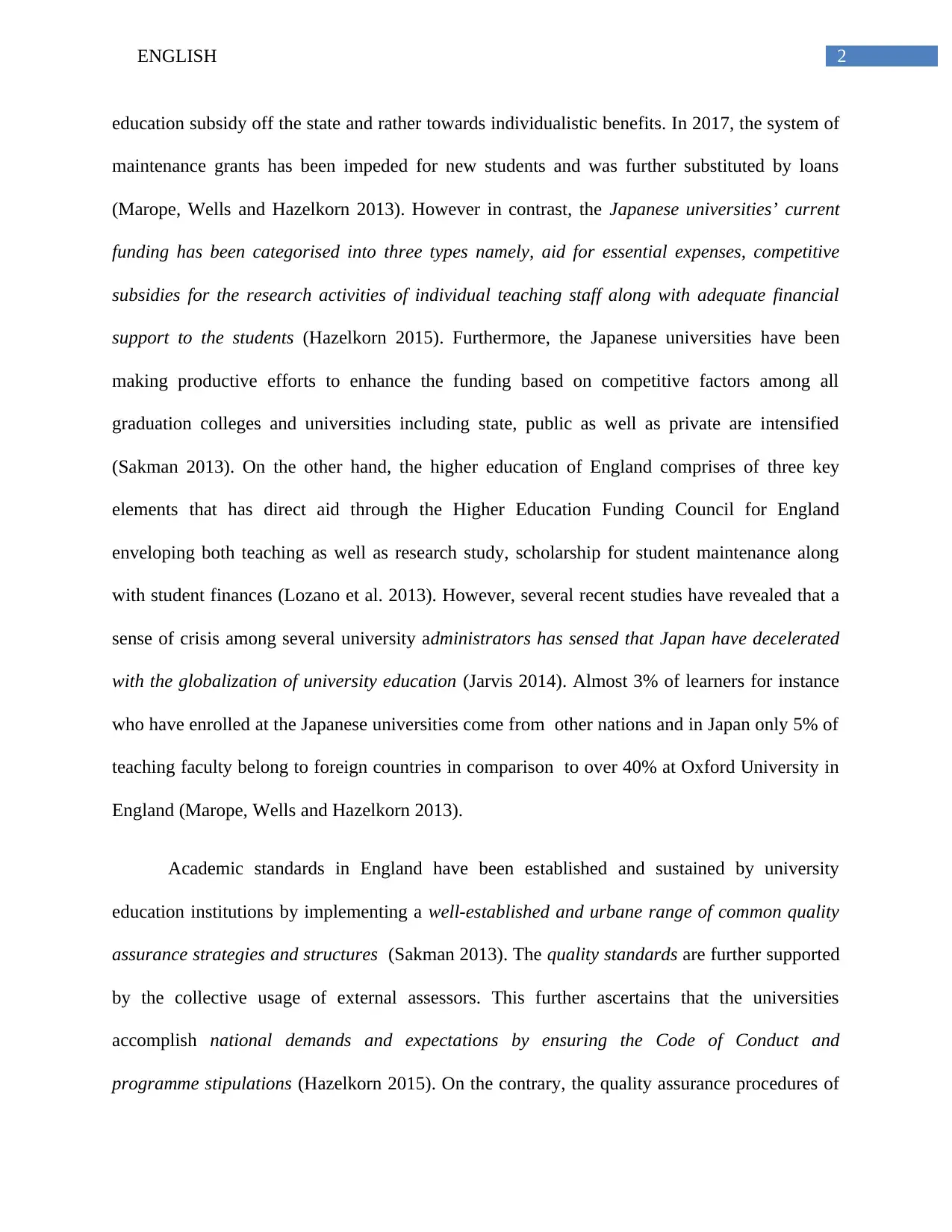
2ENGLISH
education subsidy off the state and rather towards individualistic benefits. In 2017, the system of
maintenance grants has been impeded for new students and was further substituted by loans
(Marope, Wells and Hazelkorn 2013). However in contrast, the Japanese universities’ current
funding has been categorised into three types namely, aid for essential expenses, competitive
subsidies for the research activities of individual teaching staff along with adequate financial
support to the students (Hazelkorn 2015). Furthermore, the Japanese universities have been
making productive efforts to enhance the funding based on competitive factors among all
graduation colleges and universities including state, public as well as private are intensified
(Sakman 2013). On the other hand, the higher education of England comprises of three key
elements that has direct aid through the Higher Education Funding Council for England
enveloping both teaching as well as research study, scholarship for student maintenance along
with student finances (Lozano et al. 2013). However, several recent studies have revealed that a
sense of crisis among several university administrators has sensed that Japan have decelerated
with the globalization of university education (Jarvis 2014). Almost 3% of learners for instance
who have enrolled at the Japanese universities come from other nations and in Japan only 5% of
teaching faculty belong to foreign countries in comparison to over 40% at Oxford University in
England (Marope, Wells and Hazelkorn 2013).
Academic standards in England have been established and sustained by university
education institutions by implementing a well-established and urbane range of common quality
assurance strategies and structures (Sakman 2013). The quality standards are further supported
by the collective usage of external assessors. This further ascertains that the universities
accomplish national demands and expectations by ensuring the Code of Conduct and
programme stipulations (Hazelkorn 2015). On the contrary, the quality assurance procedures of
education subsidy off the state and rather towards individualistic benefits. In 2017, the system of
maintenance grants has been impeded for new students and was further substituted by loans
(Marope, Wells and Hazelkorn 2013). However in contrast, the Japanese universities’ current
funding has been categorised into three types namely, aid for essential expenses, competitive
subsidies for the research activities of individual teaching staff along with adequate financial
support to the students (Hazelkorn 2015). Furthermore, the Japanese universities have been
making productive efforts to enhance the funding based on competitive factors among all
graduation colleges and universities including state, public as well as private are intensified
(Sakman 2013). On the other hand, the higher education of England comprises of three key
elements that has direct aid through the Higher Education Funding Council for England
enveloping both teaching as well as research study, scholarship for student maintenance along
with student finances (Lozano et al. 2013). However, several recent studies have revealed that a
sense of crisis among several university administrators has sensed that Japan have decelerated
with the globalization of university education (Jarvis 2014). Almost 3% of learners for instance
who have enrolled at the Japanese universities come from other nations and in Japan only 5% of
teaching faculty belong to foreign countries in comparison to over 40% at Oxford University in
England (Marope, Wells and Hazelkorn 2013).
Academic standards in England have been established and sustained by university
education institutions by implementing a well-established and urbane range of common quality
assurance strategies and structures (Sakman 2013). The quality standards are further supported
by the collective usage of external assessors. This further ascertains that the universities
accomplish national demands and expectations by ensuring the Code of Conduct and
programme stipulations (Hazelkorn 2015). On the contrary, the quality assurance procedures of
⊘ This is a preview!⊘
Do you want full access?
Subscribe today to unlock all pages.

Trusted by 1+ million students worldwide
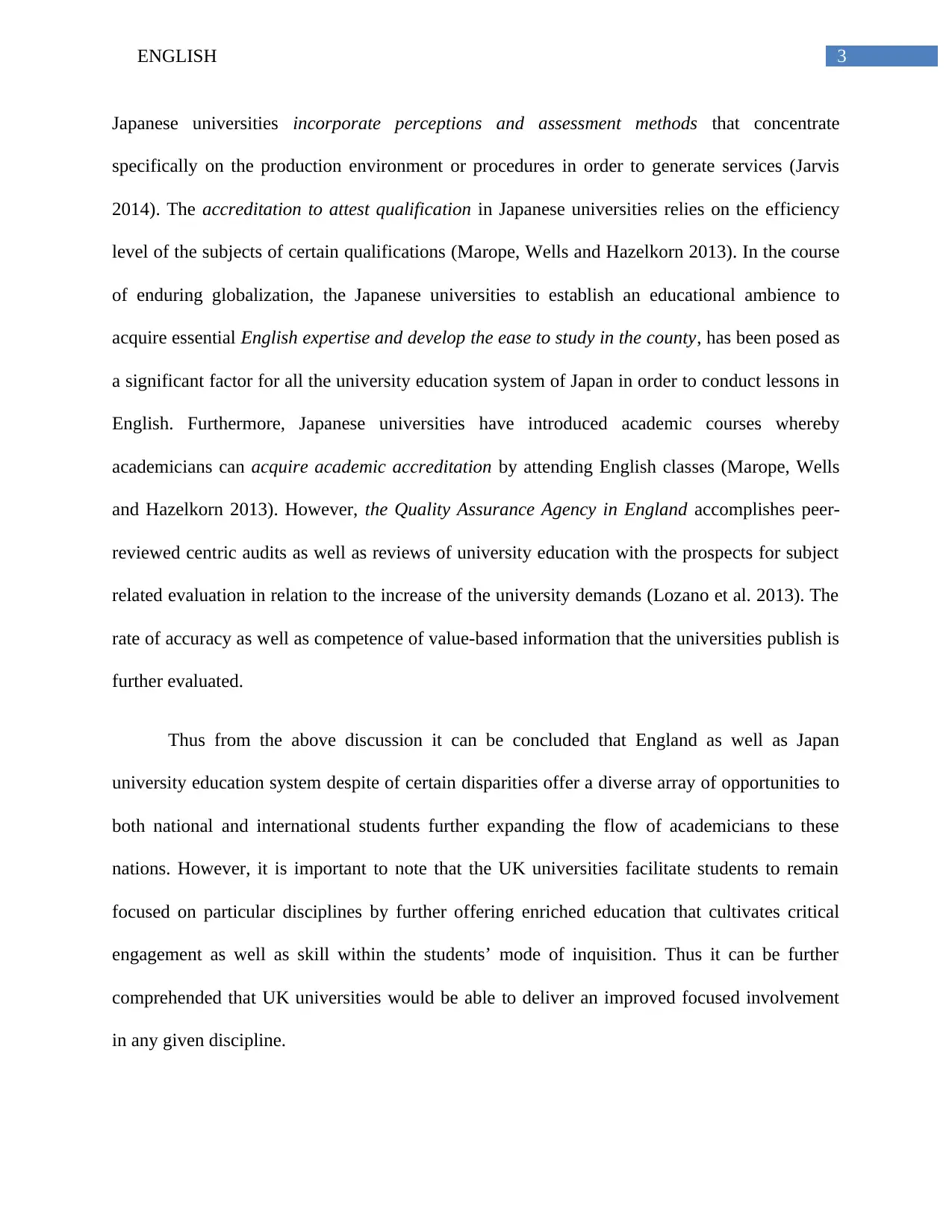
3ENGLISH
Japanese universities incorporate perceptions and assessment methods that concentrate
specifically on the production environment or procedures in order to generate services (Jarvis
2014). The accreditation to attest qualification in Japanese universities relies on the efficiency
level of the subjects of certain qualifications (Marope, Wells and Hazelkorn 2013). In the course
of enduring globalization, the Japanese universities to establish an educational ambience to
acquire essential English expertise and develop the ease to study in the county, has been posed as
a significant factor for all the university education system of Japan in order to conduct lessons in
English. Furthermore, Japanese universities have introduced academic courses whereby
academicians can acquire academic accreditation by attending English classes (Marope, Wells
and Hazelkorn 2013). However, the Quality Assurance Agency in England accomplishes peer-
reviewed centric audits as well as reviews of university education with the prospects for subject
related evaluation in relation to the increase of the university demands (Lozano et al. 2013). The
rate of accuracy as well as competence of value-based information that the universities publish is
further evaluated.
Thus from the above discussion it can be concluded that England as well as Japan
university education system despite of certain disparities offer a diverse array of opportunities to
both national and international students further expanding the flow of academicians to these
nations. However, it is important to note that the UK universities facilitate students to remain
focused on particular disciplines by further offering enriched education that cultivates critical
engagement as well as skill within the students’ mode of inquisition. Thus it can be further
comprehended that UK universities would be able to deliver an improved focused involvement
in any given discipline.
Japanese universities incorporate perceptions and assessment methods that concentrate
specifically on the production environment or procedures in order to generate services (Jarvis
2014). The accreditation to attest qualification in Japanese universities relies on the efficiency
level of the subjects of certain qualifications (Marope, Wells and Hazelkorn 2013). In the course
of enduring globalization, the Japanese universities to establish an educational ambience to
acquire essential English expertise and develop the ease to study in the county, has been posed as
a significant factor for all the university education system of Japan in order to conduct lessons in
English. Furthermore, Japanese universities have introduced academic courses whereby
academicians can acquire academic accreditation by attending English classes (Marope, Wells
and Hazelkorn 2013). However, the Quality Assurance Agency in England accomplishes peer-
reviewed centric audits as well as reviews of university education with the prospects for subject
related evaluation in relation to the increase of the university demands (Lozano et al. 2013). The
rate of accuracy as well as competence of value-based information that the universities publish is
further evaluated.
Thus from the above discussion it can be concluded that England as well as Japan
university education system despite of certain disparities offer a diverse array of opportunities to
both national and international students further expanding the flow of academicians to these
nations. However, it is important to note that the UK universities facilitate students to remain
focused on particular disciplines by further offering enriched education that cultivates critical
engagement as well as skill within the students’ mode of inquisition. Thus it can be further
comprehended that UK universities would be able to deliver an improved focused involvement
in any given discipline.
Paraphrase This Document
Need a fresh take? Get an instant paraphrase of this document with our AI Paraphraser
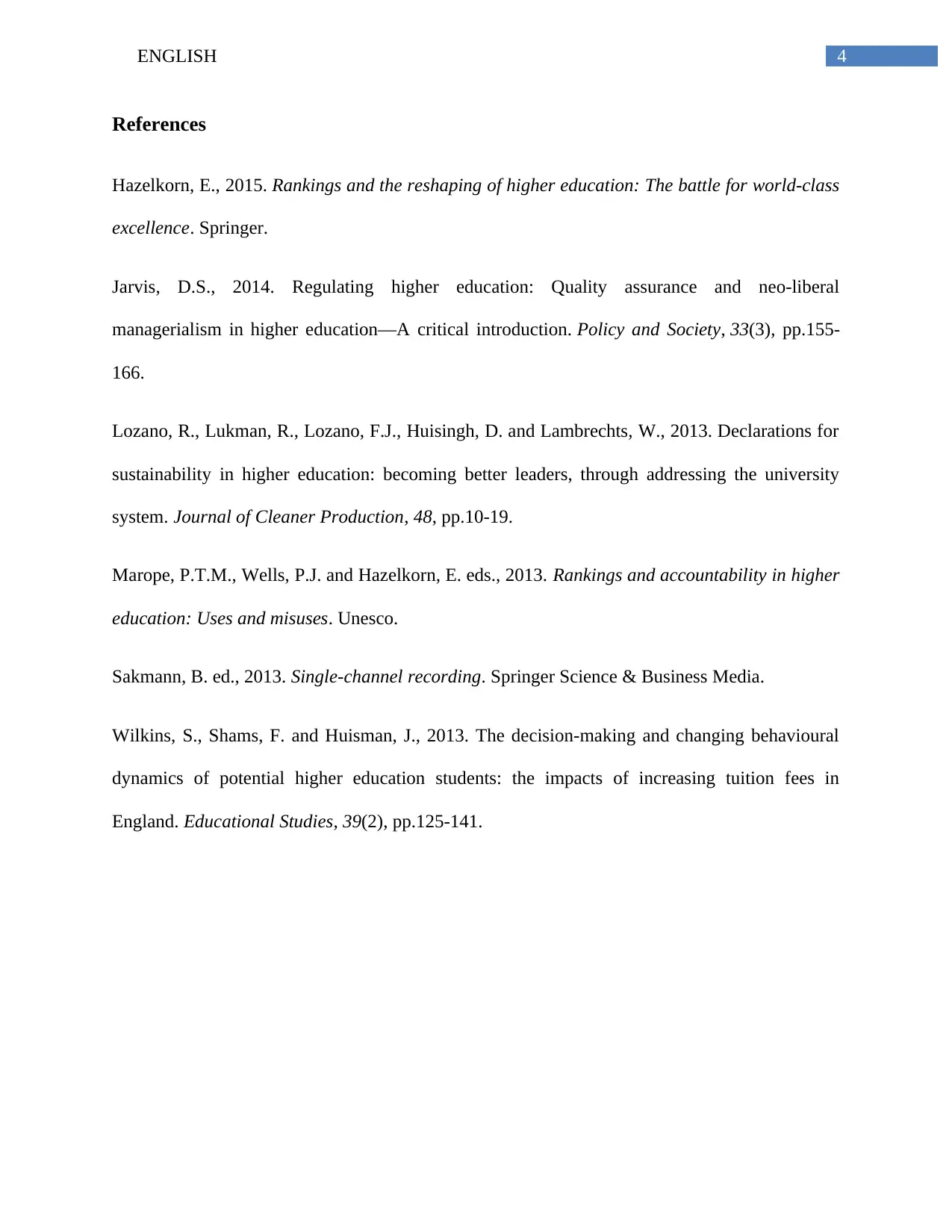
4ENGLISH
References
Hazelkorn, E., 2015. Rankings and the reshaping of higher education: The battle for world-class
excellence. Springer.
Jarvis, D.S., 2014. Regulating higher education: Quality assurance and neo-liberal
managerialism in higher education—A critical introduction. Policy and Society, 33(3), pp.155-
166.
Lozano, R., Lukman, R., Lozano, F.J., Huisingh, D. and Lambrechts, W., 2013. Declarations for
sustainability in higher education: becoming better leaders, through addressing the university
system. Journal of Cleaner Production, 48, pp.10-19.
Marope, P.T.M., Wells, P.J. and Hazelkorn, E. eds., 2013. Rankings and accountability in higher
education: Uses and misuses. Unesco.
Sakmann, B. ed., 2013. Single-channel recording. Springer Science & Business Media.
Wilkins, S., Shams, F. and Huisman, J., 2013. The decision-making and changing behavioural
dynamics of potential higher education students: the impacts of increasing tuition fees in
England. Educational Studies, 39(2), pp.125-141.
References
Hazelkorn, E., 2015. Rankings and the reshaping of higher education: The battle for world-class
excellence. Springer.
Jarvis, D.S., 2014. Regulating higher education: Quality assurance and neo-liberal
managerialism in higher education—A critical introduction. Policy and Society, 33(3), pp.155-
166.
Lozano, R., Lukman, R., Lozano, F.J., Huisingh, D. and Lambrechts, W., 2013. Declarations for
sustainability in higher education: becoming better leaders, through addressing the university
system. Journal of Cleaner Production, 48, pp.10-19.
Marope, P.T.M., Wells, P.J. and Hazelkorn, E. eds., 2013. Rankings and accountability in higher
education: Uses and misuses. Unesco.
Sakmann, B. ed., 2013. Single-channel recording. Springer Science & Business Media.
Wilkins, S., Shams, F. and Huisman, J., 2013. The decision-making and changing behavioural
dynamics of potential higher education students: the impacts of increasing tuition fees in
England. Educational Studies, 39(2), pp.125-141.
1 out of 5
Related Documents
Your All-in-One AI-Powered Toolkit for Academic Success.
+13062052269
info@desklib.com
Available 24*7 on WhatsApp / Email
![[object Object]](/_next/static/media/star-bottom.7253800d.svg)
Unlock your academic potential
Copyright © 2020–2025 A2Z Services. All Rights Reserved. Developed and managed by ZUCOL.




